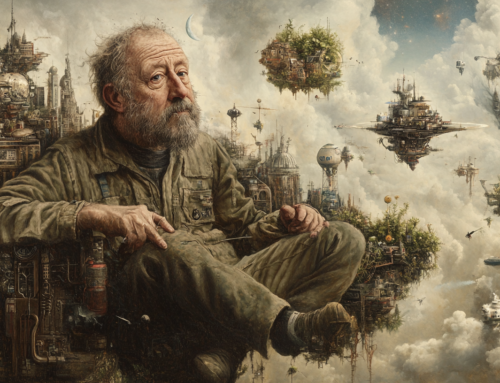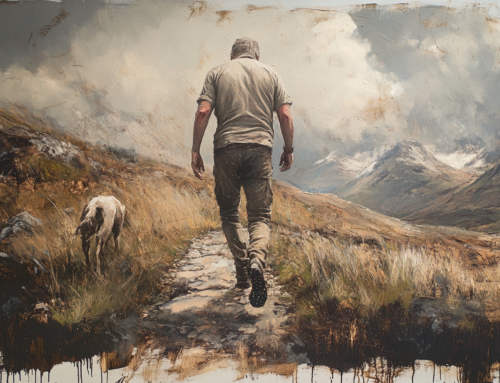“A work of art is not an end point in itself.
It’s a station on a journey.
A chapter in our lives.
We acknowledge these transitions
by documenting each of them.”
Most creators secretly try to carve statues—perfect, permanent, unchangeable. But real creative lives look more like rail journeys: you make something, you arrive somewhere new, you look around, you learn, and then—ticket in hand—you board the next train.
The quote above is a permission slip to stop worshipping the end product and start working in chapters. Each work is a station: a temporary arrival that changes you, teaches you, and points to your next departure. Your job isn’t to build a monument; it’s to keep the trains running—and to document each stop so your audience (and future self) can follow, learn, and buy a ticket for the next leg. (Sometime products are created as versions – Version 1.0, Version 2.0 etc Each version is a stop on the journey of the creator.)
This post shows how to turn that philosophy into a practical operating system for IMMachines-style creators: mindset → method → monetisation. Yes, we’ll use your GPTs as instruments along the way.
1) What the Quote Really Means (and Why It Frees You)
-
Art as station: The artifact is a snapshot of your current insight, taste, and courage. It’s not you—it’s a moment of you.
-
Journey over destination: Meaning compounds across chapters. The body of work—not any single piece—is the legacy.
-
Documentation as ritual: We acknowledge transitions by writing down what changed, why it changed, and what’s next. That ritual converts experience into reusable equity (stories, lessons, frameworks, products).
Why this matters for creators:
-
Kills perfectionism (you’re not making forever, you’re making for now).
-
Increases output (shorter cycles, clearer finishes).
-
Builds narrative (audiences bond to journeys, not statues).
-
Creates assets (each chapter spawns prompts, checklists, talks, offers).
Tell it straight: if you refuse to move on from one piece until it’s “immortal,” you’ll miss the train. Make the best thing you can this chapter, document the learning, and board the next.
2) The Station Model: 7 S’s That Keep You Moving
Think of each project (post, product, campaign) as a Station with seven steps:
-
Spark – a sentence, problem, or itch.
-
Scope – one promise you can deliver in days, not months.
-
Shape – outline, assets, structure.
-
Ship – publish the smallest true version (MVP/MVM).
-
Sense – read signals (language echoed, objections, pull).
-
Story – document what changed in you and for the audience.
-
Stage – decide the next stop (iterate, bundle, pivot, or end).
IMMachines mapping
Spark: Prompt Builder Pro or Creativity Engine GPT
Scope: From Chaos to Clarity
Shape: Thought-Leader Engine
Ship: Copy Pro Engine + Sales Angle Generator
Sense: Business Problem Solver (5 Whys on responses)
Stage: Navigator → Traffic Method Navigator → Free/Paid Traffic Engines
3) The Station Dossier: Document Each Chapter Like a Pro
Documentation is not busywork; it’s how you cash in your experience. Keep a simple, repeatable Station Dossier (Notion/Sheet/Doc). Fields:
-
Station ID: YYMM-slug (e.g.,
2510-creator-chapters) -
Artifact & Link(s): post/video/PDF/GPT name
-
Promise (≤18 words): what this station set out to deliver
-
Audience: who this was for (real names help)
-
Context: why now, constraints you accepted
-
Signals: language people echoed, questions, objections, surprising pulls
-
Learning: 3 truths you didn’t know before this station
-
Assets created: prompts, checklists, diagrams, slides, GPTs
-
Decision (Stage): iterate, bundle, pivot, or end—+ next breadcrumb
-
Quote/Story: 3–5 lines of narrative you can reuse
One-click help:
Sys Sensai: “Summarize this station into the above fields. Keep it concise and practical, in my voice.”
Thought-Leader Engine: “Turn the ‘Learning’ into a 200–400 word chapter note for my audience.”
Copy Pro Engine: “Create a ‘Station Changelog’ blog block with headline + sub + 3 bullets.”
4) The Creator Changelog: Turn Transitions into Trust
Software teams ship changelogs. Do the same for your creative business. A monthly “Creator Changelog” says:
-
What shipped (artifacts)
-
What changed (thinking)
-
What’s next (the next station)
This builds narrative continuity and earns compounding trust. People don’t just see outputs; they understand your direction—and can self-select into the next chapter.
IMMachines assist:
Sys Sensai: “Draft a monthly Creator Changelog with a calm, confident tone. Avoid hype. Invite gentle replies.”
Navigator: “Recommend where to syndicate this update for fastest feedback.”
5) From Station to System to Sales (the Equity Ladder)
Each stop on your journey can be repurposed into layered assets:
-
Sketches → Posts/Emails (signal check)
-
Scaffolds → Checklists/Prompt Stacks (lead magnets)
-
Sessions → Live/Recorded Workshops (tripwires)
-
Systems → Mini-courses / Dedicated GPTs (core offers)
-
Suite → Bundles / Membership (recurring revenue)
Only climb when the prior rung earns signal (replies, DMs, demos booked, conversions). Stations that don’t pull? Document and end with grace—then move on.
6) The 90-Minute Station Capture (Run this Weekly)
00–10: Orient
Open the last station. Ask: What actually changed? Write 3 bullets.
10–30: Distil (Sys Sensai)
Create/update the Station Dossier. Force the 18-word promise.
30–55: Story (Thought-Leader Engine)
Draft a 300–500 word “chapter note” that explains the shift without hype.
55–75: Ship (Copy Pro Engine)
Turn it into a clean blog/email block with a single soft CTA.
75–90: Stage (Navigator → Traffic Engines)
Pick the next breadcrumb (one micro-artifact to ship in the coming 48 hours) and the channel to test it.
Result: the chapter is acknowledged, assets are captured, and the next train is scheduled.
7) A 7-Day “Stations, Not Statues” Challenge
-
Day 1: Choose one project and rename it as a Station. Write the 18-word promise.
-
Day 2: Create the Station Dossier. Populate Spark/Scope/Shape.
-
Day 3: Ship a Minimum Viable Chapter (post, 1-pager, or 90-sec audio).
-
Day 4: Run 5 Whys (Business Problem Solver) on audience reactions.
-
Day 5: Publish a Creator Changelog entry (what changed, what’s next).
-
Day 6: Turn one learning into a prompt stack or checklist (lead magnet).
-
Day 7: Decide the Stage (iterate, bundle, pivot, or end) and schedule the next Station.
Do this for four weeks and you’ll have 4 documented chapters, a narrative spine, and multiple assets ready to sell or bundle.
8) Pitfalls That Kill Momentum (and Simple Fixes)
-
Perfectionism statue-carving: You polish instead of move.
Fix: Set a “Station Service Level Agreement”: nothing sits unshipped for more than 7 days. -
No documentation ritual: Lessons evaporate; you repeat mistakes.
Fix: 90-minute Station Capture. Calendar it. Non-negotiable. -
Scope creep: One station becomes a saga.
Fix: Promise ≤18 words; deliverable ≤90 minutes for the first version. -
Narrative gaps: Audience can’t follow.
Fix: Monthly Creator Changelog. End each post with “Where I’m headed next.”
9) The Spiritual Core (and why this helps mid-life creators)
Seeing each work as a station disarms ego and invites flow.
You honour the present chapter without demanding it be the whole book. For mid-life creators, that’s rocket fuel: you already have patterns, scars, and standards. The only trap is attachment to past peaks or fear of new valleys. Station thinking keeps you humble, moving, and light.
Also: documenting is gratitude in action. It says, “This changed me.” Gratitude keeps the tracks clear for the next train.
10) Copy-Paste Prompts (drop into your GPTs)
Station Dossier Builder — Sys Sensai
“Create a Station Dossier from this draft and links.
Fields: Station ID, Promise (≤18 words), Audience, Context, Signals, Learning (3 bullets), Assets created, Decision (Stage), Quote/Story (3–5 lines). Keep voice calm and clear.”
Chapter Note — Thought-Leader Engine
“Turn the Dossier’s ‘Learning’ into a 350-word chapter note: what changed, why it matters, and one practice to try. Tone: compassionate, no hype.”
Creator Changelog Block — Copy Pro Engine
“Draft a monthly Creator Changelog: What shipped (3 bullets), What changed (3 bullets), What’s next (1 sentence + soft CTA).”
Stage Decision — Business Problem Solver
“Using audience reactions and metrics, recommend: iterate, bundle, pivot, or end. Provide 1-week plan with 3 tasks, each <60 minutes.”
Next Train — Navigator / Traffic Method Navigator
“Given this Station and audience, pick the lowest-friction channel and craft a 7-day distribution plan (1 action/day).”
Closing: Keep Your Ticket Stamped
A chapter doesn’t need to be perfect to be true. If you document the transition and board the next train, your body of work will become something statues never can: alive.
Stations, not statues. Chapters, not commandments. Document, depart, repeat.
I’ll meet you on the platform.






